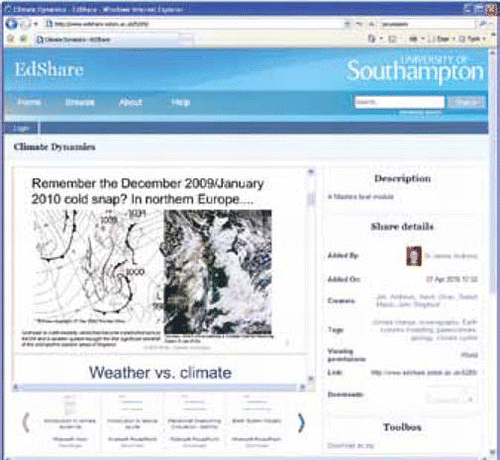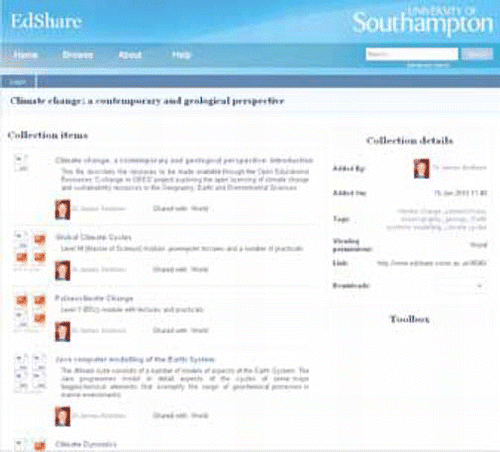Abstract
The Southampton experience of OER has been successful in repurposing over 50 CAT points of climate change resources. There is evidence of culture change amongst those staff who have contributed resources when clearing third party material, and successful negotiations with publishers have depended upon establishing contacts and networking in order to side-step a standardized web process. The level of resource required to repurpose materials means it is unrealistic to expect a widespread take up in UK educational institutions unless, at a national level, the community can negotiate agreements with the major scientific publishers. The requirement of authors to relinquish their copyright when publishing journals has significantly impeded open access in this project. Local repositories currently offer a more user friendly interface than JorumOpen.
Introduction
The School of Ocean and Earth Science (SOES) at the University of Southampton has a critical mass of researchers exploring climate change, both from a contemporary and palaeoclimate perspective. At all levels, the curriculum is strongly informed by their output which translates to >65 credit points of material. SOES researchers agreed to make openly available 60 CAT points of climate change resources as a partner in the C-change GEES project.
The University is fortunate in hosting several successful OER bids. Although there is yet no written policy in respect of intellectual property rights (IPR), the University strongly supports open access.
At a local level there were a number of motivating factors with which we were able to engage academic staff, principally:
To provide a shop window for the University benefiting outreach and enabling better marketing of courses targeted at lifelong learning/ employer engagement.
To disseminate state of the art knowledge, concepts and hypotheses about climate change as understood by internationally recognized scientists working at the frontiers of their fields.
To provide a robust evaluation of climate change data to a wide variety of interests, ranging from professionals, teachers, students and the media.
To allow users to engage in the public climate change debate and carbon economy challenge in a more comprehensive and knowledgeable way.
Getting started
Academic staff and postgraduates currently owning or contributing to the resources were recruited to the project following face-to-face briefings. Climate change material is distributed across eight 15 CAT point modules, ranging from level one to level M and accessed by over 700 undergraduate and postgraduate students. To provide focus, three stand alone modules and an Earth Systems modelling package were selected for repurposing.
The M-level module ‘Climate Dynamics’ provides a rigorous introduction into the processes underlying climate variability and climate change on a timescale of decades or longer. It places emphasis on the ocean's key role and introduces the development and use of a hierarchy of climate models, including simplified models that help to obtain conceptual understanding.
The M-level module ‘Global Climate Cycles’ provides a ‘hands-on’ approach to understanding the key concepts, numerical methods, and interpretation of climate-related research across the geological past (focusing on the Cenozoic).
The Level-3 module ‘Palaeoclimate Change’ examines mechanisms of palaeoclimate change in the earth-ocean-atmosphere system from those operating on short time-scales (e.g. abrupt climate change, orbitally paced cycles) to those operating at multimillion year time-scales.
The Jmodel (Java) suite consists of several computer box models of different aspects of the Earth System which are principally used for practical work in a level 3 module ‘Biogeochemical Cycles in the Earth System’.
At an early stage (September 2009) the GEES Subject Centre arranged an IPR workshop for academic project partners which was hosted at the Open University. IPR and workflow guidance for the Southampton team was provided by the C-Change project coordinator immediately prior to detailed work commencing.
Methodology
A team of 5 PhD students and a post doctoral research assistant was recruited to undertake the vetting and editing of module materials; mostly lectures and practicals. The project was coordinated by the Southampton-based GEES Subject Centre Senior Advisor for Earth Science. The team maintained close links with the C-Change project coordinator who provided initial training in how to approach intellectual property rights and copyright issues.
Initially, each team member was assigned a number of resources (2008/09 lectures/practicals/problem sheets) readily available on the local virtual learning environment (Blackboard). The process then involved:
Sourcing material not already sourced.
Establishing copyright ownership and approaching the copyright holder for permission to release under a Creative Commons (CC) share-alike license (CitationCreative Commons, 2010).
Editing the resource to provide context and appropriate acknowledgements.
Sharing experiences at a weekly meeting.
Southampton is fortunate in that the materials can be placed directly into EdShare, a University repository which enables open access.
Challenges and responses
Sourcing material
SOES colleagues contributing resources have been largely positive and helpful, albeit not always easy to prise away from their research. However, for one module (Climate Dynamics), it proved difficult to source much of the material as the module has evolved through a number of staff in recent years, and most of the material was not authored by the 08/09 coordinator. Though two of the previous coordinators have left the University and a third has retired, when approached they have been helpful. For delivery in March 2010, this module was completely restructured with a new member of staff taking the coordinator role. The previous coordinator was positive about this repurposing exercise as he was of the view that the old module was no longer ‘fit for purpose’. Because of these issues, the team focused on other resources only returning to this module at a late stage in the project. However, a positive outcome has been that when writing/rewriting lectures for the revised 2010 Climate Dynamics course, colleagues paid much more attention to sourcing and attributing materials.
Another issue highlighted by the project team is that the M-level resources were found to contain more peer reviewed material and were therefore correspondingly more complex and time consuming to process.
Copyright clearance
The project was quite successful in obtaining clearance from government, institutional and commercial publishers. Keele have provided useful data (CitationWhitfield and Robinson, 2010) which is mirrored by the Southampton experience. Most large international publishers now have a standardized web process for requests to reproduce their materials.
These usually seek to charge a significant fee for each individual item. It has proved difficult to circumvent this by finding an alternative contact, though in most cases we managed through persistence and networking with GEES colleagues. Nevertheless, the goal of releasing all materials via a CC license has had to be moderated as some publishers would only allow release of their material under terms varying from a CC license.
Editing and quality assurance
The large number of contributors to the resources inevitably creates a variety of styles of presentation. To edit this to one ‘house’ style, though desirable, would have seriously impacted on the final volume of resources produced. Responsibility for the final output was largely devolved to individual members of the team overseen by the local coordinator. At a practical level, commensurate with the terms of the project, it was necessary to evaluate the viability of posting some existing resources without having to significantly amend or add to the content. Though it was sometimes possible to circumvent copyright restrictions by replacing or redrawing illustrations, a few PPT/PDF lectures were discarded because too much of the material was owned by one or two publishers from whom permissions were not forthcoming. Very occasionally there was insufficient text for the viewer to follow the arguments and the author was too committed elsewhere to provide additional guidance. Staff were only initially prepared to sign up on the basis that they did not have to commit any additional time to the repurposing.
Potential misrepresentation or misuse of resources
In the spirit of the chosen CC license, we wanted to release material in a form in which it is easily edited, e.g. as a PPT file. Some staff were uncomfortable with this, not least because they argued that their work could be edited by unscrupulous parties and subsequently passed off with deliberate errors to undermine their scientific credibility and that of climate change science. We resolved this issue by depositing some material as PDF files. Ultimately, the source of the material in the repository is write-protected and provides a safeguard.
Results
The final outputs () totalling over 50 CAT points of resources and over 90 learning objects, have been produced by approximately 1700 hours of PhD student time, which equates to one person working for nearly 1 year.
Southampton is fortunate in already having a repository (EdShare) in which resources can be placed on open access. The resources are deposited as Word, PPT and PDF files in a collection of 4 parts (; see referenced websites). An overview was provided for each part and for the collection. The resource can also be accessed via a link from JorumOpen. Since going live in March 2000, there has been an average of two downloads per day of learning objects with the download rate accelerating as the collection grows.
There is also an issue regarding OER becoming ‘static’. For example, once a resource is deposited in JorumOpen, it cannot be edited. However, Southampton and other universities are fortunate in having a local repository which enables constant updating and editing. The JorumOpen updating process will need renewing as OER becomes established.
Conclusions
The Southampton experience of OER has been successful in repurposing over 50 CAT points of climate change resources. There was a risk that the project would fail at a local level through lack of detailed academic staff engagement. Fortunately this has not been a significant problem but did lead to a small amount of redundant work on one module (Climate Dynamics) and a delay in being able to process this material.
One of the overarching project aims was to promote a significant shift in culture towards open licensing by GEES schools and departments. There is evidence of culture change amongst those staff who have contributed resources. When rewriting lectures for the new Climate Dynamics course, colleagues have paid much more attention to sourcing the materials. To engage researchers not directly involved in OER, effective local dissemination will be important. During the project, an interesting initiative was undertaken using some of the C-change material in a distance learning short course package.
It has become clear that successful negotiations with publishers have depended upon establishing contacts and networking in order to side-step a standardized web application process. It is unrealistic to expect that the person-application resources required here to repurpose materials will lead to a widespread take up in UK educational institutions unless, at a national level, the community can negotiate agreements with the major scientific publishers. Others have managed this e.g. MIT. If permission is not forthcoming, it is pertinent to ask why academic researchers so readily give up their copyright to third party publishers and whether they should in future publish only where open access is subsequently guaranteed.
Acknowledgements
This contribution was a C-change in GEES project funded under the JISC/HEA Open Educational Resources initiative. The additional advice and support offered by the project co-ordinator, Ed Bremner, was greatly appreciated.
References
- WhitfieldS. and RobinsonZ. 2010 Open Educational resources: the challenges of ‘usability’ and copyright clearance, Planet, 25
- Creative Commons (CC) 2010 http://www.creativecommons.org.uk/ Accessed 21 October 2010

